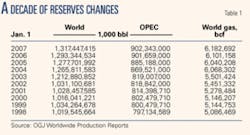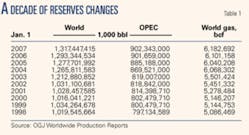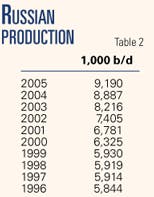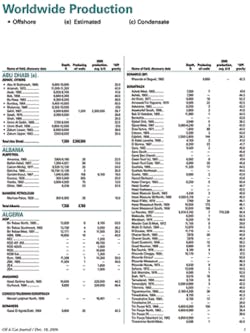Worldwide oil and gas reserves rose in 2006 as oil production posted a small increase from a year earlier, according to Oil & Gas Journal’s annual worldwide survey of production and reserves. Remaining oil reserves still exceed estimated cumulative production.
Reserves estimates for oil are up 2% from the previous survey, while gas reserves estimates are 1% greater (OGJ, Dec. 19, 2005, p. 20). Total proved crude and condensate reserves stand at 1.317 trillion bbl, and proved natural gas reserves are 6.18 quadrillion cu ft.
The volume of oil reserves held by members of the Organization of Petroleum Exporting Countries moved up slightly from the previous survey, but OPEC’s estimated gas reserves were down a bit. The organization controls 68.5% of the world’s proved oil reserves and 51% of total proved gas reserves.
OGJ’s estimates of proved reserves are compiled from a survey of official sources. Since most countries don’t reassess resources annually, many estimates are unchanged from the previous report.
Reserves changes
Most changes to reserves estimates are small due to a combination of this year’s production and recent discoveries. In addition, higher oil prices have resulted in reevaluations due to economics.
Canada and the US this year reported higher oil and gas reserves, but Mexico’s newest estimates are declines. Oil reserves in Brazil and Argentina are higher, while gas reserves in those countries moved lower. Collectively, oil and gas reserves for countries in the Western Hemisphere changed negligibly from the previous report.
The Canadian reserves estimate is predominantly oil sands.
The country’s conventional oil reserves are estimated at 5.2 billion bbl, up 20% from a year ago, according to the Canadian Association of Petroleum Producers (CAPP). The increase is due in large part to revisions to the three producing projects off Newfoundland, CAPP said.
The Alberta Energy and Utilities Board estimates Canadian oil sands reserves at 174 billion bbl.
Reported reserves in the UK declined for both oil and gas. The changes are due to this year’s production as well as reserves revisions in established fields and reserves additions from new field developments, including those resulting from recent exploration success, the UK Department of Trade and Industry reported.
OGJ reports gains for a few countries’ reserves based on new data. For example, oil reserves in Kazakhstan, Sudan, and Equatorial Guinea are up sharply from the previous report as a result of better information from operators in those countries.
Due to the change in Kazakhstan’s reserves, collective oil reserves in Eastern Europe and the former Soviet Union are up 26%, leading all other regions in combined changes.
Propelled by increases for Australia and China, gas reserves estimates in the Asia-Pacific region are up 7%, while Western Europe’s gas reserves declined 10% from a year ago. The other regions collectively show little or no change to gas reserves.
OPEC countries’ reserves are little changed from a year earlier. Oil reserves are reported slightly higher for Iran, Algeria, Libya, and Nigeria but a bit lower for Saudi Arabia. OPEC marginally adjusted its gas reserves in a handful of its member countries.
US reserves
The latest estimates from the US Energy Information Administration show increases for both oil and gas reserves during 2005.
Proved reserves of dry natural gas in the US increased 6% during 2005, the largest annual increase since 1970. Last year’s was the seventh increase in a row for gas reserves. Recording a 2% increase, US crude oil reserves moved up for the first time in 3 years.
EIA reported that gas reserves additions onshore in the Lower 48 states were large enough to overcome a 10% decline in gas reserves for federal areas of the Gulf of Mexico. Texas and Colorado led reserves additions with increases in Newark East field of the Barnett Shale and tight sands and coalbeds of Ignacio-Blanco field.
Most gas reserves additions were from extensions of existing fields rather than new field or reservoir discoveries. Field extensions totaled 21.05 tcf last year, while new field discoveries were 942 bcf. New reservoir discoveries in old fields were 1.21 tcf.
Coalbed methane reserves increased 8% and accounted for 10% of dry gas reserves in the US last year, as production climbed less than 1% from 2004.
EIA also reported that while several large deepwater discoveries made recently have not yet been booked as proved reserves, reserves additions of crude oil replaced 122% of 2005 production. Texas reported the largest oil reserves additions, mostly in the Permian basin. Wyoming and Montana posted the second and third largest increases.
Total 2005 discoveries of crude oil in the US were 1.05 billion bbl, with new field discoveries of 205 million bbl, mostly from the federal Gulf of Mexico. New reservoir discoveries in old fields amounted to 41 million bbl.
In addition, EIA reported that proved reserves of natural gas liquids in the US increased 3% last year as operators replaced 130% of production. Total NGL reserves stood at 8.165 billion bbl at the end of 2005.
Oil production
Cumulative worldwide crude oil production surpassed 1 trillion bbl during 2006, according to calculations based on DeGolyer and MacNaughton figures indicating cumulative output of 986.5 billion bbl through 2005 (OGJ, Nov. 27, 2006, p. 20).
Worldwide crude and condensate production this year averaged 72.39 million b/d, according to OGJ estimates. This is up from 72.26 million b/d last year.
The region with the largest gain in crude output this year is Eastern Europe and the former Soviet Union. This increase was led by oil production in Kazakhstan, Russia, and Azerbaijan.
Some regions saw a collective decline in oil production this year. Output in Western Europe declined almost 10% from a year earlier, as Norway, Denmark, and the UK reported lower oil production.
Combined oil production in North America and Latin America was just 0.4% lower than during 2005. While Canada and Brazil recorded increases, Mexico and the US posted declines for this year. OGJ estimates that US oil production averaged 5.135 million b/d, down from 5.178 million b/d last year.
OPEC oil production this year averaged an estimated 29.66 million b/d vs. 29.77 million b/d last year. Indonesia, Saudi Arabia, Venezuela, and Nigeria posted declines, while production in Kuwait and Qatar is estimated to have increased.
Click here to download the Worldwide Reserves & Production Survey.
OGJ subscribers can download, free of charge, OGJ Worldwide Report 2006 tables from the OGJ Online home page at www.ogjonline.com. Click “OGJ Online Research Center,” then “OGJ Subscriber Surveys,” then “Worldwide Production” or “Worldwide Refining.”





